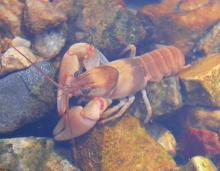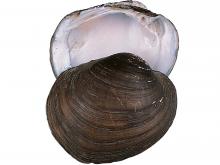Aquatic Invertebrates
Media

Species Types
Scientific Name
Faxonius luteus (formerly Orconectes luteus)
Description
The golden crayfish varies in color from olive green to golden yellow. Many body parts are trimmed with red. A dark band crosses the head just in front of the cervical groove, and another crosses the carapace at its junction with the abdomen. It's a wide-ranging species.
Media

Species Types
Scientific Name
Venustaconcha ellipsiformis and V. pleasii
Description
These small mussels use darters, a type of fish, as hosts for their young.
Media

Species Types
Scientific Name
Lampsilis abrupta
Description
This endangered native mussel lives in flowing waters of large streams among gravel and cobble.
Media

Species Types
Scientific Name
Bivalve molluscs in order Unionoida
Description
Secretive and seldom seen, freshwater mussels are extraordinarily diverse in Missouri. We have nearly 70 species within our borders. Many are declining, and several are endangered.
Media

Species Types
Scientific Name
About 32 North American species in the family Notonectidae
Description
Sometimes called “water bees” or “water wasps,” backswimmers are predaceous and can deliver a painful bite if mishandled. True to their name, they swim belly-up, and their backs are keeled like a boat, which makes back-swimming easier.
See Also
About Aquatic Invertebrates in Missouri
Missouri's streams, lakes, and other aquatic habitats hold thousands of kinds of invertebrates — worms, freshwater mussels, snails, crayfish, insects, and other animals without backbones. These creatures are vital links in the aquatic food chain, and their presence and numbers tell us a lot about water quality.





















